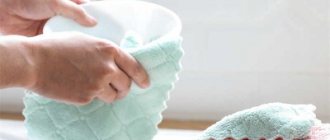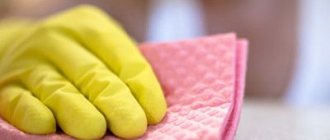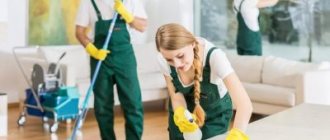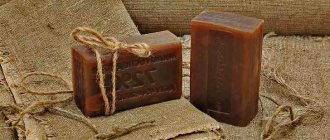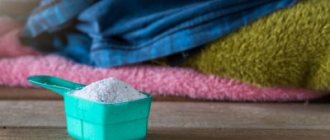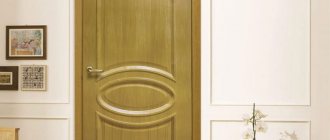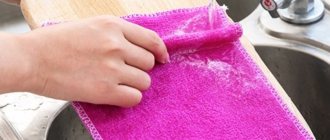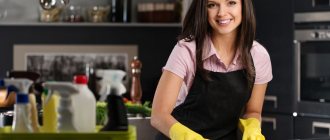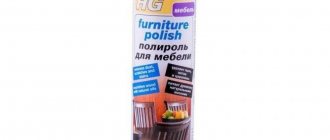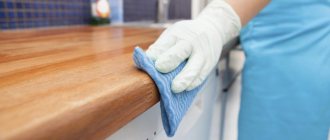A rag for washing the floor is the most important equipment on which the quality of cleaning throughout the house depends.
If in past years housewives used old towels and bed linen, now the situation has changed. There are many rags made from different materials on sale.
Read the article on how to choose the best floor cleaning cloth that will last a long time.
What is microfiber
A synthetic material consisting of two interwoven microfibers, polyester and polyamide, with split ends in the form of hooks. In all respects, this fabric is superior to cotton and viscose products.
Synthetic product
Professional cleaning companies use three types of rags for cleaning:
- natural, made of cotton and linen;
- artificial viscose;
- synthetic, made of polyamide and polyester.
All varieties have different properties of softness, strength, wear resistance and elasticity, and the ability to absorb water. Microscopic fibers, twisted in a special way, cope with cleaning any surfaces.
Microfiber
The household market offers napkins and rags for cleaning, pet care, optics and computer equipment, car washing and kitchen.
The popularity of the material was achieved thanks to:
- Penetrating effect when cleaning microcracks and pores.
- The ability to absorb dust, water and dirt due to the internal space between the fibers, giving the surface antistatic properties.
- The capillary effect of suctioning the smallest droplets of moisture.
- The ability to remove fat without additional surface treatment.
- Safely clean delicate surfaces.
- Maintains quality after numerous washes and intensive use due to durability.
- Ability to remove bacteria due to capillary effect.
- When cleaning, use cleaning agents and detergents in minimal quantities as unnecessary.
Universal cleaning product
Conclusion
Despite the fact that polyester and polyamide fiber appeared in Russia relatively long ago, not everyone has yet managed to become acquainted with its miraculous properties. Every housewife wants to make the process of cleaning floors easier and faster, but getting rid of limescale stains is not an easy task.
Only with the invention of microfiber has it become possible to avoid scrubbing floors several times. The video in this article will tell you more about the use of modern rags in everyday life.
If you need to buy a hovercraft in Moscow on the best terms, call or write to us! We will be glad to mutually beneficial cooperation and are happy to offer you the best products at excellent prices: we sell wedges and clamps in different sets, so you can safely contact us if you need them, because you can purchase them from us in approximately the same quantity, as much as you need. Therefore, contact us! You will be pleasantly surprised by our conditions! See you in touch!
Methods of obtaining
The worldwide popularity of the material, developed at the end of the 20th century, came in the 80s and later. The fabric was invented in 1976 using a previously found formula for twisting ultra-thin fibers 0.06 micrometers thick. Hot exposure to alkali when dissolved on polyester threads leads to a loss of the original mass of the fiber.
On a note! In the created matter, each thread consists of intertwined microscopic fibers from 50 to 150 pieces. Two manufacturing methods are used - direct and connected extrusion.
- The first method does not provide for the production of ultra-fine fibers, but is aimed at the formation of uniform synthetic threads. The finished fibers are intertwined.
- The second extrusion option connects the constituent components by passing through a star-shaped hole and then dissolving the fibers. The initial combination of two types of components.
You may be interested in: What waterproof fabrics exist for outdoor use?
Technological device for cleaning floors
Based on the components included in the manufacturing process, products are divided into fabrics made from beech cellulose (for the production of bed linen and clothing), polyamide (knitwear and underwear).
On a note! It is used in the manufacture of clothing for polar explorers, athletes, sports balls and shoes, and medical supplies.
Fabrics of synthetic origin
Today you can buy floor rags not only from natural fabrics, but also from fabrics of synthetic origin. Despite their unnaturalness, they are in great demand and have excellent qualities. To produce such rags, various raw materials are used, ranging from oil to glass and metal .
Acrylic rags and polyamide
Acrylic is an artificial fabric made from acrylic acid. In appearance it is similar to wool. That is why it is often used to polish parquet floors to a shine.
Polyamide is a fairly durable fabric that not only has a pleasant-to-touch surface, but also an attractive appearance. After cleaning with such a rag, the floor not only becomes shiny and clean, but also dries quickly. With proper care, fabric of this type will last a long time without losing its original appearance. Today you can find floor cleaning cloths in rolls, which are made of polyamide. They are most often purchased for production and enterprises, as they have a large footage.
Types of microfiber napkins and rags
Separating fabric products from their intended purpose improves the quality of cleaning:
- artificial suede is used for delicate surfaces of optics, laser discs, plasma TV screens, jewelry, silverware;
- for glass, mirrors, dishes, chrome surfaces, polished furniture; It is possible to use a small amount of detergent;
- waffle cloth for the kitchen, for wiping vegetables and as a hand towel;
- universal fabric can be used both dry and wet to remove dust or dirt;
- “anti-dust” is used for paintings, icons, antique furniture made of unpolished wood;
- for wet cleaning, with maximum absorbency, when washing the kitchen, shoes, fighting dirt and liquids;
- with an abrasive mesh for removing burnt food, cleaning glass from insects, and residues of building materials on smooth surfaces;
- ribbed microfiber removes traces of cosmetics, cleans the oven, tiles and heavily soiled household items;
- a napkin-sponge for washing dishes and a scrubber instead of a metal “scourer” for the kitchen.
Mop attachments
Cleaning equipment for medical institutions
Carts, mops, containers, rags, mops must be clearly marked or color-coded taking into account the functional purpose of the premises and types of cleaning work and must be stored in a designated area. The rags are marked as follows: rags for cleaning in staff rooms and wards are marked in blue; red - for cleaning bathrooms; green – dressing rooms, treatment rooms; yellow – utility rooms.
A color coding scheme for cleaning equipment in medical institutions should be located in the equipment storage area.
Toilet cleaning equipment must be color coded to indicate special attention. Cleaning equipment for the toilet: rags, buckets, brushes are labeled and stored separately from other cleaning equipment.
Equipment for cleaning toilets must be clearly marked in red, which is used in areas with a high degree of bacterial contamination. In the specialized literature there is often a definition that cleaning equipment for cleaning bathrooms must have a signal marking .
Should cleaning equipment for production, utility and auxiliary premises be marked with paint ? – the answer to this question is definitely “Yes!” Also, such cleaning equipment should be stored in separate rooms equipped with special washing baths ( washing equipment ) and drainage devices with hot and cold water supply, as well as a register for drying cleaning equipment.
How to choose a microfiber floor cloth
Depending on the coating material, special fabrics are selected. Parquet, linoleum, laminate or tile require a different approach to cleaning from dirt. Using old towels for modern coverings is not practical. Modern microfiber rags have many advantages over rags:
- Easy to do push-ups.
- Absorbs dirt without smudging.
- They don't leave streaks.
- Clean without re-grinding the surface.
- They do not crumble into threads or lint.
- Durable.
Floor cleanliness affects the health of residents.
On a note! When choosing microfiber for the floor, they rely on the following requirements - the ability to quickly absorb moisture and remain soft.
The choice between natural and synthetic materials depends on the preferences and requirements of the housewife.
Faux suede
Cotton does not fray or stretch after repeated washings, but it wears out quickly and leaves streaks. The addition of viscose only affects the service life of the rag.
Viscose does not leave lint on the laminate, absorbs water perfectly, retains its shape and color, lasts a long time, but is not resistant to high temperatures. May leave streaks on dark and polished surfaces. A successful combination of viscose and polyester.
Acrylic made from natural gas. Feels like wool. It interacts with acids and alkalis, but has low hygroscopicity and is not suitable for wet cleaning.
On a note! Used for polishing parquet or laminate flooring.
You may be interested in this Features and applications of acoustic felt
Polyamide dries quickly without losing its shape and elasticity. Resistant to the formation of fungi and rotting processes. It has a high price that justifies the quality of the material.
Mop attachment
Microfiber remains a favorite among other floor cleaning fabrics. Instant absorption of any type of contaminant, except kitchen fat, which reduces the quality of hygroscopicity. Can be used with warm water detergents. Resistant to hot processing and washing at high temperatures. Durable.
Important! Any of the selected fabrics must undergo periodic treatment with disinfectants.
How does the production process work?
To obtain viscose, you need to complete several stages of work:
- get a sliver of wood and boil it in a special alkaline solution;
- After cooking, the mass is formed into a slab;
- bleach the resulting slabs;
- break them into fibers, which become the main synthetic material.
You can find several types of viscose fabric. Manufacturers prefer to create cleaning wipes from a sponge material that perfectly absorbs moisture due to its thickness and is easy to wring out.
How does a microfiber mop make cleaning easier?
The necessary task of cleaning floors becomes a pleasure with a modern mop. Blue microfiber cleaning cloths clean hard-to-reach areas with cracks and crevices.
The porous structure of the dense material captures the smallest particles of dirt and dust, attracting them with an electrostatic charge during dry cleaning. The hair and fur of the animal sticks like a magnet. High hygroscopic properties allow you to absorb water 4-5 times more than the volume and weight of the rag.
Cleaning brushes
Mops are available with rag or rope attachments and replaceable sets for heavily soiled surfaces. Technological mops with microfiber and spin control occupy a leading place in sales. The high cost of such a device when purchased translates into savings over time on cleaning time and the use of detergents. Hundreds of washes that the fabric can withstand will extend the operation, with proper care of the nozzles, for many years.
Washing at high temperatures, boiling mode, adding conditioner and accelerated hot drying is prohibited.
Cleaning glove
Individually wrapped microfiber cloth
Grateful customers from among housewives, car enthusiasts, office workers, cleaning companies and representatives of various industries appreciated the new material.
Non-woven and knitted microfiber cloths are common. The former are used for dry and wet cleaning, including delicate surfaces. Used in hotels, train stations, airports.
The latter, with a softer and more voluminous structure, are suitable for washing equipment and surfaces using large amounts of water and detergents.
Rules for selection and application
Size and color practically do not matter; any high-quality napkin guarantees quick cleaning. Therefore, you just need to pay attention to the manufacturer to always buy the best options.
For long-term operation, it is enough to follow simple rules:
- choose cleaning products according to the type of surface;
- hand wash with laundry soap;
- dry by hanging on crossbars, since in a crumpled state pathogenic microflora can form on wet viscose;
- The washing process can be repeated 2-3 times, after which it is recommended to throw it away.
How to wash floors correctly: housewife's recommendations
Mops with attachments are not suitable for cleaning baseboards at the same time, so cleaning protruding surfaces and reliefs must be done before cleaning the floors with a flat attachment or rubbing with polish.
Laminate flooring in dark shades should be washed using movements directed parallel to the laid sheets.
On a note! Incoming solid particles of dirt can leave streaks on the surface. The tiled mirror floor is washed with a damp cloth and then polished with a dry one.
How to wash a microfiber cloth: effective methods
The following recommendations will help extend the life of the product:
- wash in warm water no higher than 50-60 degrees;
- using laundry soap or washing powder for hand washing;
- do not use ironing or forced drying of the product;
- Contaminants of any complexity can be removed by normal washing or repeated rinsing;
- drying should be carried out in a straightened form and in a natural way;
- When washing in a machine, choose a delicate cycle without spinning;
- The use of air conditioning is not recommended.
You might be interested in Description of the properties and appearance of tulle: products made from such fabric
On a note! Multifunctional fabric can withstand up to 500 regular washes. Do not boil, iron or bleach rags.
Proper care of products
In order for the rag to last as long as possible, you must follow the following care rules:
- after cleaning is completed, it is soaked for 10-15 minutes in a washing solution, after which it is thoroughly rinsed and squeezed out;
- The product should be dried flat; it is better to discard the battery, since high temperatures lead to thinning of any fibers;
- to destroy bacteria, you can place a rag in direct sunlight, ultraviolet light will kill all pathogenic flora;
- After drying, the rag is carefully folded and placed in a dry place; if it is stored in conditions of high humidity, fungi will begin to multiply in it.
Rags must be replaced in a timely manner. Over time, even the highest quality products lose their ability to remove dirt, they lose their attractive appearance, begin to fray, and leave behind streaks. Products that have reached the end of their useful life should be discarded.
Myths about using microfiber for cleaning floors
Using detergents damages microfiber. Only the content of chlorine and other aggressive components intended for use in hand protection products can damage the fabric structure.
Microfiber scratches delicate lenses, mirrors and laboratory instruments. Artificial suede, specially designed for cleaning such surfaces, copes with its tasks. Freeing from trapped solid particles of dirt is done by shaking.
Slippers
Microfiber does not contain special additives to fight bacteria. The properties of the capillary effect make it possible to remove harmful microorganisms along with absorbed moisture and dust.
On a note! The friction of twisted fibers in the material creates static electricity, which holds dust until washed.
Universal qualities are used for polishing furniture, window glass, mirrors, dishes, plumbing fixtures and tiles, and car surfaces. Microfiber cloths are popular due to their antibacterial properties, which are ensured by the high hygroscopicity of the fabric. A simple and durable household item is used in cosmetology, medicine, food and chemical industries.
Microfiber floor cloth
The freshness of the air and the state of health directly depend on the quality of floor cleaning. Modern means eliminate the use of old rags in the form of torn T-shirts or old towels. Increased hygiene requirements are associated with an increase in allergic diseases. High-quality general cleaning is ensured by modern microfiber floor cloths. The presence of two or more types of products is determined by different floor coverings.
On a note! A microfiber cloth is a universal way to clean the surface of plastic, stainless steel, and glass. It is affordable and has a long service life.
Microfiber is many times more effective than traditional cloths. Revolutionary microfiber is actively used in light industry, giving comfort and coziness.
Microfiber rags are already commonplace in everyday life and in production, and demand generates an increase in production and improvement of products using new fabric. Increasingly, purchases are made in bulk. Therefore, rolled fabric is sold by the meter. The cost of one meter ranges from 600 to 3000 rubles. depending on the composition.
Finished raw materials and products meet all the requirements of world standards. The use of microfiber in many areas highlights its versatility.
Marking of cleaning equipment at catering establishments
It is not regulated by a clear purpose of colors. Therefore, each enterprise can independently designate its own colors for each zone. For example, red is for cleaning a meat shop, blue is for a fish shop, green is for a vegetable shop, yellow is for a flour shop. Employees often wonder what color equipment is used to clean the distribution area ? – you can use green color, it can also be used for cleaning equipment of bar counters and tables where food is consumed.
Another frequently asked question: is specially marked cleaning equipment required for refrigerated rooms ? – the answer is definitely “Yes!”, for cleaning each group of premises (hot and cold shops, meat and fish shops, flour and confectionery shops, semi-finished products preparation shops, procurement shops, non-refrigerated warehouses, refrigerated chambers, auxiliary premises, sanitary facilities ) allocate separate marked cleaning equipment, in accordance with the requirements of SanPiN 2.3.2.1324-03 “Hygienic requirements for shelf life and storage conditions of food products.”
